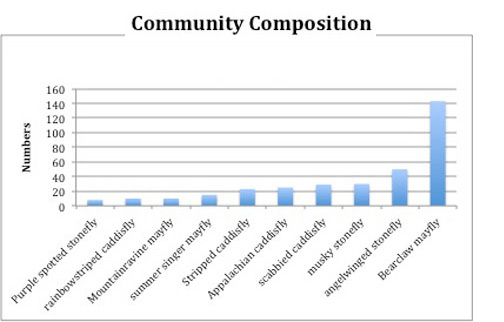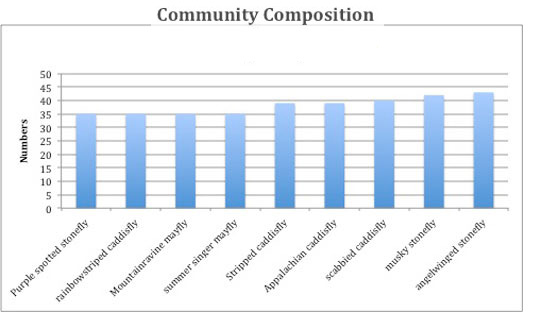The rich and the dominant
Birders look for birds, but we're going to look for aquatic species, like insects. Why? What's so special about insects? Do we really want to "save the stream for mayflies"?
Some reasons that we look for insects are purely practical -- they are a bit easier to find than birds, and they rapidly reflect changes in the water chemistry. However, there is a more important reason as well: aquatic insects are at the base of a lot of food chains -- they are eaten by fish, birds, amphibians, small mammals... If the aquatic insects can't survive, then a lot of the ecosystem falls apart.
Back in the 1980s, the EPA (Environmental Protection Agency) came up with a way to evaluate ecosystem health quickly, efficiently, and cost effectively. They called their method Rapid BioAssessment (RBA), and they based it (in part) on aquatic insects. Specifically, you look at the number and type of aquatic insect species you find in a polluted stream, and compare it to the number and type you find in a clean ("pristine") stream.
The first part of an RBI is just the total number of species, called "richness". Richness is pretty easy to calculate: just check off all the species you find on a checklist, then count the checks.
But just because a stream has a lot of species does not make it healthy. For example, one species could be dominating the whole system and the rest could just be barely making it.
So we can calculate a second score, called %dominance, to tell us if the stream is dominated by its top species. This is also easy to do: just take the number of individuals in the most common species, divide it by the number of all individuals, and multiply by 100. (*note: in larger samples, dominance is usually calculated as the percent of the top 3 species).
Roll over the images below to see the difference in %dominance.
You can see that this ecosystem is dominated by the Bearclaw mayfly. The others are relatively rare.
This system has the exact same total numbers of individuals, but they are distributed pretty evenly among many different species. Generally, a system with lower %dominance (or higher evenness) is more healthy.
Copyright University of Maryland, 2007
You may link to this site for educational purposes.
Please do not copy without permission
requests/questions/feedback email: mathbench@umd.edu

